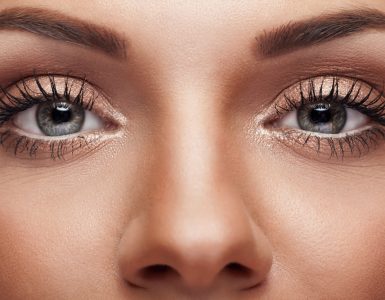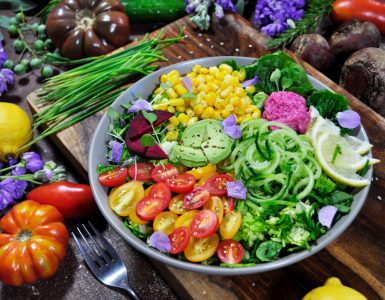Hot flushes are a common symptom of the menopause and they can quickly put a damper on day-to-day activities.
Editor Jane Garton looks at some natural ways to cool things down when the going gets hot.
‘I’m having a flush’ is a familiar mid-life cry. Hot flushes and night sweats are the most common menopausal symptom affecting up to eight of every ten menopausal women.[i] Their intensity, frequency and duration vary. Some women barely notice them while others are plagued day and night with unpleasant surges of intense heat lasting anything from 30 seconds to 10 minutes.
It is not known for sure what causes night sweats and hot flushes but it is thought that the decline in oestrogen that occurs around the time of the menopause may affect the hypothalamus. This is the region of the brain that controls body temperature[ii]. As a result our bodies overreact to the multiple tiny fluctuations in body temperature we all experience throughout the day. This can be in response to changes in ambient temperature, stress or what we are wearing to name a few.
Typical triggers include heat, increased humidity, alcohol, caffeine and spicy foods. For some women even a hot drink or walking into a warmer room are enough to trigger that dreaded surge of heat.
Many women resort to Hormone Replacement Therapy (HRT) to fight the flushes. But if you would rather try a more natural route, there are two herbs in particular that may help to cool things down.
Sage
Also known as salvia officinalis, sage is a member of the mint family contains oestrogen-like substances that have been shown to help relieve hot flushes and night sweats. It appears to have a rebalancing effect on the hypothalamus, a small gland in the brain, which acts as the control centre for regulating body temperature. A study carried out[iii]on menopausal women in Switzerland who took capsules of fresh sage once a day reported a reduction in the severity and number of hot flushes after eight weeks.
It may sound counterproductive as it is a hot drink, but you can also try sage tea. Put one or two teaspoons of freshly crushed sage leaves in a covered cup of boiling water and leave to stand for around 15 minutes. Drink three to four cups a day.
Black Cohosh
Native Americans have used black cohosh Cimicifuga racemosus for more than 200 years, after they discovered the root of the plant helped relieve menstrual cramps. These days it is mostly used for menopausal symptoms such as hot flushes as well as irritability, mood swings and sleep disturbances.
Several studies have looked at its effects with positive conclusions. A 2010 analysis of seven clinical trials of more than 1,400 perimenopausal women, aged 40-60 concluded that black cohosh could reduce hot flushes and sweating by around a quarter (26%) compared to placebo[iv].
No one knows for sure how black cohosh works. Early studies suggested that plant hormones (phytoestrogens) found in its roots had a direct oestrogen-like action. More recent thinking, however, suggests it may act in a slightly different way – by blocking the action of oestrogen in some tissues while enhancing it in others. This action is much like medications called SERMs (Selective Oestrogen Receptor Modulators), prescribed as an alternative to HRT women who don’t want to, or can’t, use it[v],[vi].
Other theories suggest it may act on the mood hormone serotonin in the brain in a similar way to SSRIs (Selective Serotonin Reuptake Inhibitors). Used to treat depression, they can also combat hot flushes.
How you can help yourself deal with hot flushes:
Breathe deeply
The moment you feel a flush coming on, stop what you are doing and take several slow, deep, calming breaths.
Layer up
Wear several layers of clothes, which are easy to peel off.
Keep it light
Use lightweight duvets and bedclothes. Keep a fan next to your bed to cool down at night.
Go natural
Opt for cotton nightwear and avoid any made from manmade fibre.
Hydrate, hydrate
Drink plenty of water to avoid dehydration.
Spray it.
Keep a spray in your fridge to help cool you down if the going gets hot. Always carry some cool wipes in your handbag.
Stub out now
Smoking ups the risk of flushing.
Beat stress
Make time to relax every day: try meditation or yoga.
Avoid triggers
Steer clear of alcohol, spicy foods, hot drinks and soups.
Exercise regularly
Brisk walking, stretching, muscle-strengthening and relaxation exercises can help reduce even severe menopausal symptoms.
[i]https://www.nhs.uk/conditions/menopause/symptoms/
[ii] https://www.healthline.com/symptom/hot-flashes
[iii] Bommer, S., Klein, P. & Suter, A. Adv Therapy (2011) 28: 490. https://doi.org/10.1007/s12325-011-0027-z
[iv] Shams T, Setia MS, Hemmings R, et all. Efficacy of
black cohosh-containing preparations on menopausal symptoms: a meta-analysis.
Altern Ther Health Med. 2010 Jan-Feb;16(1):36-44.
[v] Ruhlen RL, Sun GY, Sauter ER. Black Cohosh: Insights into its Mechanism(s) of Action
[vi] https://www.menopause.org/for-women/what-selective-estrogen-receptor-modulators-(serms)-can-do-for-you
























Add comment